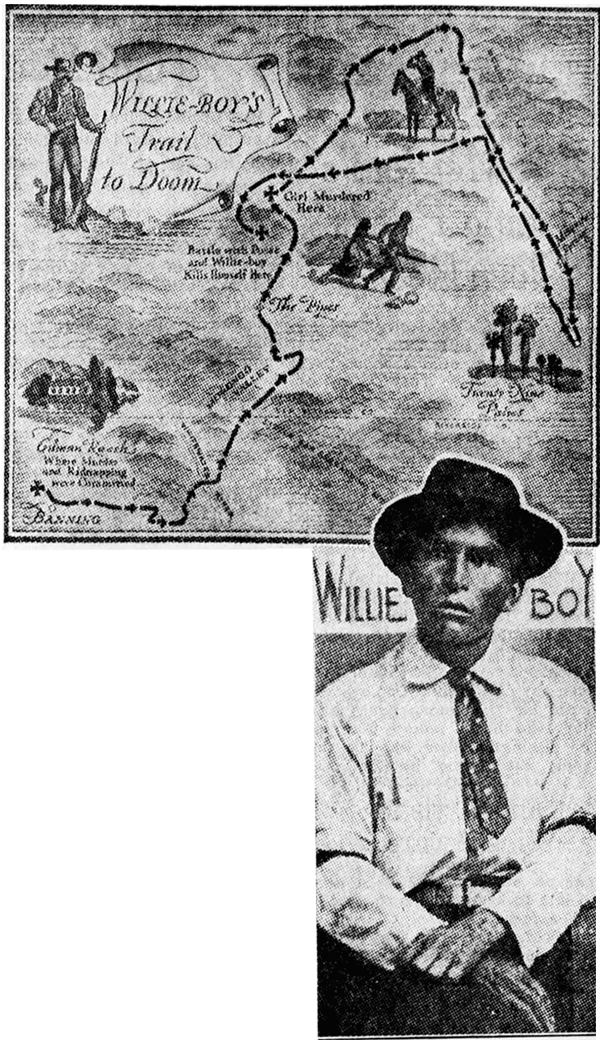Famous Desert Man-Hunt For Willie-Boy Recalled
How Willie-boy, kidnapper, and murderer evaded posses of San Bernardino and Riverside counties in the greatest desert man-hunt of the century, is recalled for old-timers in the April issue of West-ways, official magazine of the Automobile Club of Southern California.
William S. Wood’s article, called “Bad Indian in the Morongos,” describes the wild flight of the young Piute, known only by his nickname of Willie-boy.
Redlands men stepped forward yesterday with additional information about the colorful incident of 1909, which followed the murder Sept.27 of Mike Boniface on the Gilman ranch northwest of Banning.
WORKED IN REDLANDS
Before the midnight slaying of Boniface, Willie-boy had worked in a Redlands brick yard for A. E. Taylor.
After the longs search for Willie-boy had started, the horses of a sheriff’s posse were shod at Big Bear valley by John M. Stocker, now Redlands constable.
“Threatening Mike’s wife with a rifle, which he had stolen out of one of the ranch buildings, Willey-boy told her he would come back and kill her if she notified the officers,” says Wood’s story. “Then he ordered the oldest daughter, 14-year-old Isoleta Boniface, to come with him, and the pair disappeared into the darkness.”
GO TO WHITEWATER
“When news came of the murder to Ben de Crevecouer at dawn,” the story continues, “he immediately organized a posse and started after Willie-boy. They followed the trail of the murderer and the girl through the orchards to the Southern Pacific railroad. East of Cabazon, the trailers found where Willie-boy and his captive had struck for the hills to the south. At One-Horse Spring ,southeast of Cabazon, they found the pair had spent some time. Then the trail led east again through the pass. Near Fingal a low spur from San Jacinto peak projects into the pass. Up this spur and on to the south face of the mountain the trail led. Finally the tracks led downward toward the lonely and isolated Whitewater ranch.
ESCAPE IN THE DESERT
“Cautiously the small posse divided and the members stationed themselves at various points around the ranch. Through a wild night of storm and wind they watched thinking to close in Willie-boy in the morning. But sometime before dawn he and his captive escaped to Whitewater canyon. He s Here the posse picked up the trail and on a smooth bit of wind-blown sand found where the girl had scrawled in Piute signs, ‘He is going to kill me.’ “
The flight led through Morongo valley and to the Pipes in San Bernadino county. San Bernardino county officers joined the hunt with Sheriff J. C. Ralphs and Deputy Sheriff Carles Reche in charge.
“Soon the footprints revealed a cruel story to the trailers,” says Wood. “The girl’s footsteps were lagging and suddenly they came on the body of poor Isoleta, sprawled face down on a huge slab of granite. She had evidently reached the limit of her strength and Willie-boy had shot her through the heart in the same cold-blooded fashion in which he had killed her father. The body was still warm.”
The mounted posse carried Isoleta’s body back to Banning, outfitted again hastily and returned to the desert, establishing a base camp at Sunrise Springs. Willie-boy’s trail was found again south of Ludlow, returning to Twenty Nine Palms in the succeeding days, he doubled back to the Bullion mountains, then headed west toward the distant hills where he had killed Isoleta.

DEPUTY IS WOUNDED
It was in the maze of granite hills south of Saddlerock Spring that “about 1 in the afternoon as the five men rode down a sandy wash bordered by huge piles of weathered granite, the crack of a rifle came from somewhere high up in the rocks and Charles Reche tumbled from his saddle. Willie-boy had come to bay at last.”
Well-concealed, Willie-boy shot horses from under the deputies, but where the bullets came from it was impossible to tell. Eleven bullets followed the one which wounded Reche.
“Willie-boy could have killed his pursuers at will,” said John Stocker, who has hunted through the granites with Frank J. Loge and others from Redlands. “But,” he said, “Willie-boy had shouted from the hills that he wouldn’t kill any white men but he would kill Reche, his enemy, if he had the chance.”
COMMITS SUICIDE
Through the night the posse lay crouched behind rocks. The shooting had ceased. At length about 10:30, they had heard a single, muffled shot. In the morning, the posse, returned to Banning with the wounded Reche.
“The final hunt began to assume the nature of a military expedition,” says Wood. “Sheriff Ralphs led a party through Bear valley, another started from Victorville and a third from Banning.”
They found Willie-boy’s body in a hollow of rocks, where a week before they had heard the final shot. He had taken off one shoe, placed the rifle to his head and pulled the trigger with his toe.
USED LAST BULLET
Stocker maintained yesterday that Willie-boy never could have been dislodged from his stronghold among the granites if his ammunition had lasted.
“He might have starved,” said Stocker, “but he could have withheld an army except for the fact that he had reached the end of his rope. He used his last bullet on himself.”
Joe Waite, part Indian, did most of the desert tracking of Willie-boy, said Stocker, Waite still lives in this district, he said.

